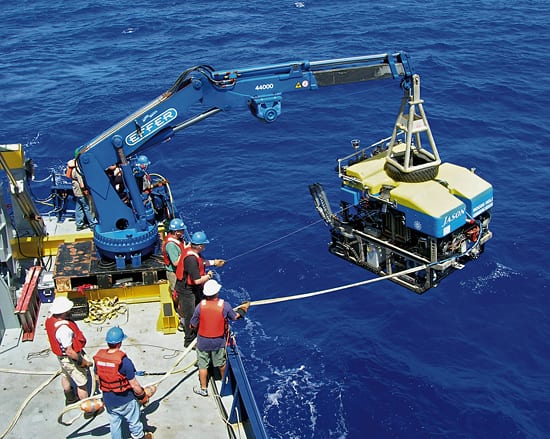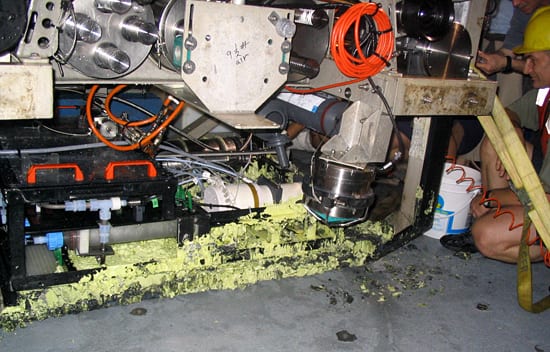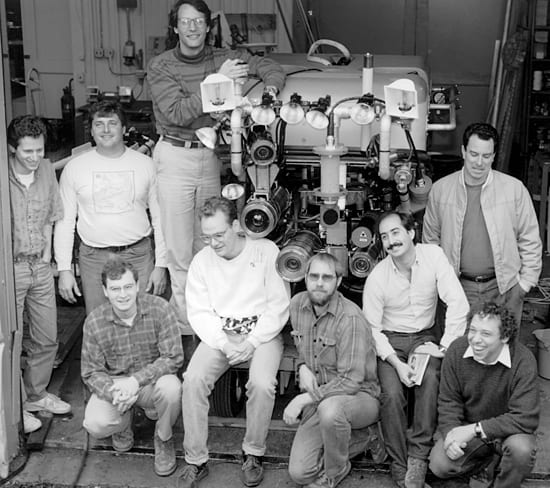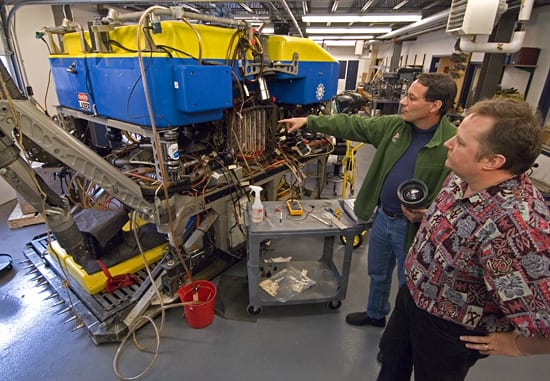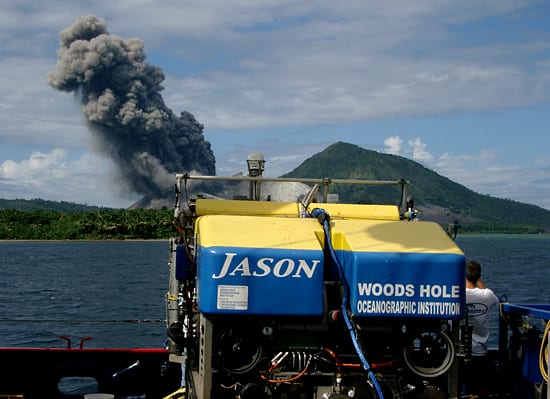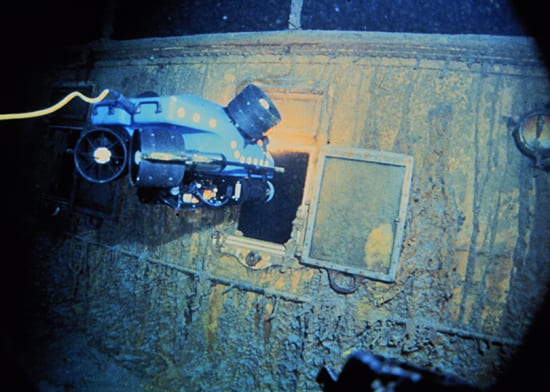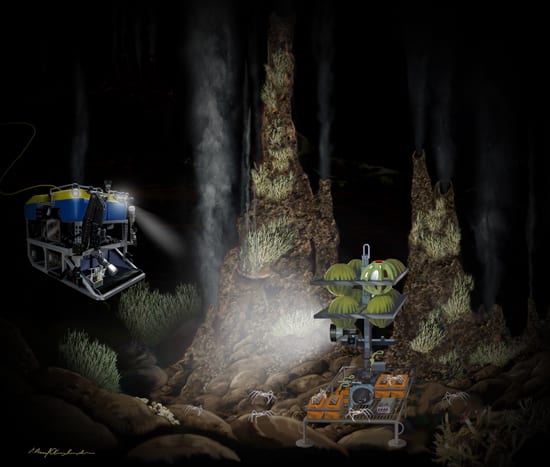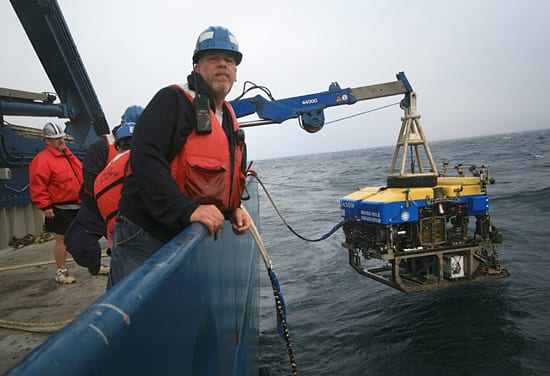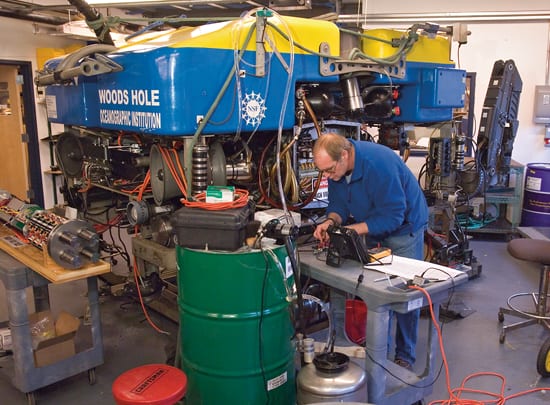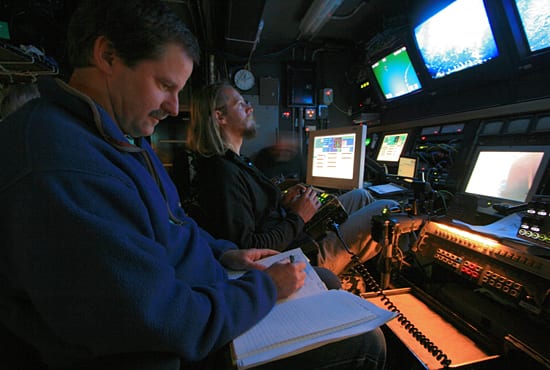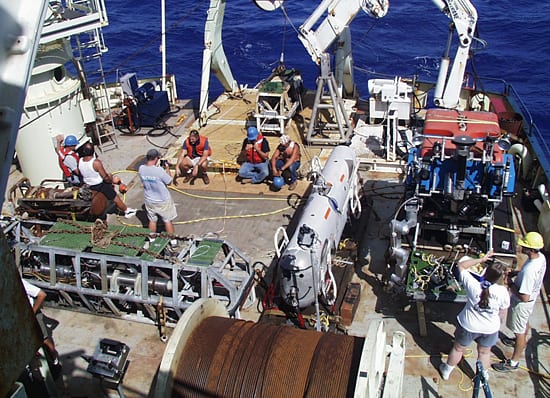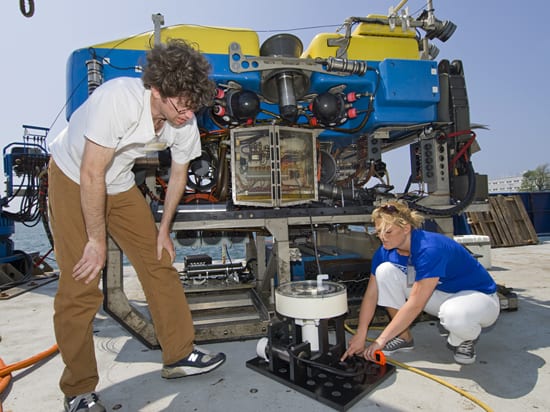Jason in Photos
- The remotely operated vehicle Jason is lowered in the Pacific Ocean in 2006 to explore an erupting underwater volcano near the Marianas Islands. Sensors left near the site indicated that the volcano, called Northwest Rota-1, still showed signs of activity. The deep-sea explorer returned to the site in April 2009, where scientists found that the volcano was still erupting. (Photo by Tom Bolmer, Woods Hole Oceanographic Institution)
- Sulphur coated the frame on the remotely operated vehicle (ROV) Jason during a cruise to the western Pacific. Jason captured close-up images of volcanic eruptions and was bathed in liquid sulfur from a seafloor vent known as the Brimstone Pit. The vehicle was not damaged but smelled like rotten eggs! (Photo by William Sellers, Woods Hole Oceanographic Institution)
- Engineers and students from the WHOI Deep Submergence Laboratory gather around the first full-scale Jason remotely operated vehicle (ROV) in the Blake Building in 1990. Now in its third generation, the Jason family of vehicles (Jason Jr., Jason, and Jason II) played a key role in establishing ROVs as important and viable platforms for deep sea research. Jason is now a key component of the National Deep Submergence Facility, based at WHOI. Front row, left to right: Dave Mindell, Hagen Schempf, Bob Elder, Bob Weiman, and Dana Yoerger; second row: Marty Marra, Steve Gegg, Andy Bowen, and Martin Bowen. (Photo courtesy of Woods Hole Oceanographic Institution Archives)
- Engineer Andy Bowen (in green) and Chris German, chief scientist for deep submergence, with ROV Jason during a maintenance period in Woods Hole. (Photo by Tom Kleindinst, Woods Hole Oceanographic Institution)
- The ROV Jason II and Robert Fuhrmann look on as Mount Tavurvur belches ash. The photo was taken from the deck of R/V Melville as it left Rabaul, Papua New Guinea, on a cruise to the Manus Basin for chief scientist Maurice Tivey. (Photo by Phil Forte, Woods Hole Oceanographic Institution)
- Ninety-five years ago today, the "unsinkable" Titanic struck an icebergand sank into 12,500 feet (3800 meters) of water in the North Atlanticsoutheast of Newfoundland. In July 1986, nine months after their discovery of the wreck, the WHOI Deep Submergence Laboratory team returned to the site to conduct test dives as part of the continuing development of the lab’s Argo/Jason imaging system, designed forscientific missions to explore and photograph the deep sea floor. In this image, Jason Jr. peers through a hatch into one of the Titanic's state rooms. (Photo courtesy of Woods Hole Oceanographic Institution Archives)
- This artist's concept shows the "deep-sea light post" alongside the remotely operated vehicle (ROV) Jason (left) near a black smoker vent on the ocean floor. The light post uses a single, 1,200-watt bulb (20 times more powerful than the average 60-watt household bulb) and is powered by five 100-pound batteries.
(Illustration by E. Paul Oberlander, Woods Hole Oceanographic Institution) - Expedition leader Will Sellers evaluates oncoming ocean swells as the crew prepares to lower the remotely operated vehicle Jason to the Pacific's Juan de Fuca Ridge. Now in its third incarnation, the Jason vehicles have been taking researchers to the seafloor (without leaving the deck of a ship) for more than 20 years. (Photo by Lance Wills, Woods Hole Oceanographic Institution)
- Research Engineer Bob Elder tests refurbished pigtail wiring before reinstalling electrical components during a rebuild of the remotely operated vehicle Jason. Designed and built by WHOI’s Deep Submergence Laboratory, Jason allows scientists to have access to the seafloor without leaving the deck of a ship.
(Photo by Tom Kleindinst, Woods Hole Oceanographic Institution) - Seated inside the control van for the remotely operated vehicle Jason, pilot Scott Hansen (background) and chief scientist Bill Chadwick (Oregon State University) work to collect samples from the hydrothermal vents along the Juan de Fuca Ridge in the North Pacific. (Photo by Lance Wills, Woods Hole Oceanographic Institution)
- Scientific gear and underwater vehicles crowd the fantail of the research vessel Knorr during a 2001 expedition to explore the mid-ocean ridge in the Indian Ocean. The first-generation remotely operated vehicle Jason rests on the right; its companion imaging and lighting vehicle Medea sits beneath the A-frame. The Argo II towed imaging and mapping vehicle (left) and original DSL-120 towed sonar sled fill the mid-deck. (Photo by Amy Nevala, Woods Hole Oceanographic Institution)
- While on board R/V Roger Revelle at the WHOI dock in July 2008, Summer Student Fellow Kaitlyn McCartney (MIT) adjusted a sampler designed by WHOI Post-doctoral Scholar Chip Breier (left, Applied Ocean Physics and Engineering Department.) The new "SUPR" sampler (Suspended Particulate Rosette) collects particles within intensely hot, high-pressure fluid plumes rising from hydrothermal vents—part of efforts to analyze deep-sea compounds in place. McCartney, sponsored by engineer Sheri White, designed the frame to mount SUPR on the ROV Jason (background), and participated in a cruise to collect particles from mid-Atlantic black smoker vents. (Photo by Tom Kleindinst, Woods Hole Oceanographic Institution)
Image and Visual Licensing
WHOI copyright digital assets (stills and video) contained on this website can be licensed for non-commercial use upon request and approval. Please contact WHOI Digital Assets at images@whoi.edu or (508) 289-2647.

